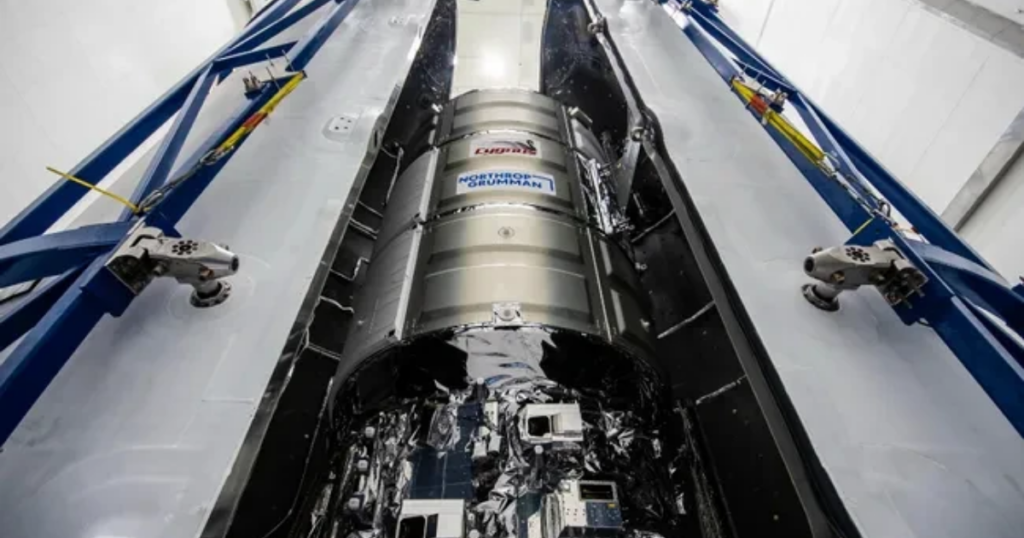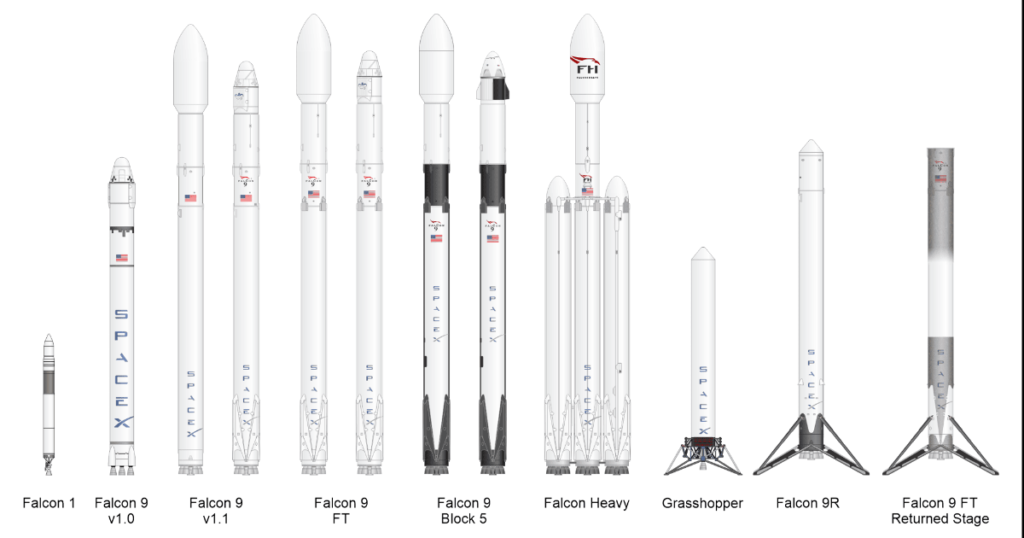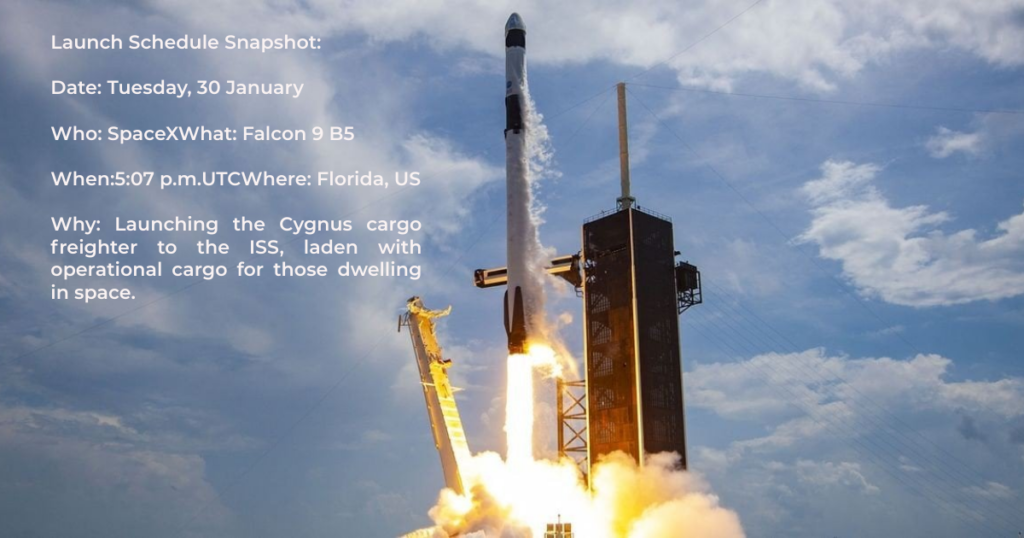Space X Falcon 9: In a groundbreaking move, SpaceX is set to unleash the power of its iconic Falcon 9 rocket to propel the Northrop Grumman Cygnus spacecraft into the cosmic realms on January 30. This historic collaboration marks a significant stride in space exploration, as the Falcon 9, a marvel of SpaceX’s ingenuity, takes center stage in delivering the Cygnus cargo to the International Space Station (ISS).
Founded in 2002 by visionary entrepreneur Elon Musk, SpaceX stands as a pioneering force in the realm of space transportation.
Headquartered in Hawthorne, California, SpaceX oversees its production facilities and mission control, strategically positioning itself at the forefront of innovation. The company conducts vital rocket testing activities near McGregor, Texas, and Brownsville, Texas, while also maintaining operational launch pads at Kennedy Space Center, Cape Canaveral, and Vandenberg Air Force Base. The early trials of the Falcon 1, a testament to SpaceX’s commitment to progress, took place at Kwajalein Atoll in the Pacific Ocean.
Beyond its launch capabilities, SpaceX has ventured into cutting-edge technology with the development of the Dragon space station re-supply vehicle. Under a contractual agreement with NASA, SpaceX regularly undertakes missions to ferry essential supplies to the International Space Station, cementing its integral role in advancing space exploration.
At the pinnacle of SpaceX’s engineering feats is the Falcon Heavy, a three-core rocket that boasts three modified Falcon 9 first stages. Recognized as one of the most potent rockets presently in service, the Falcon Heavy embodies SpaceX’s relentless pursuit of pushing the boundaries of space travel.
In tandem with cargo missions, SpaceX has also turned its attention to crewed space travel with the creation of the Crew Dragon spacecraft. A product of NASA’s Commercial Crew Development (CCDev) program, Crew Dragon plays a pivotal role in transporting astronauts to and from the International Space Station, marking another significant stride in SpaceX’s contributions to the exploration of outer space.
Falcon 9 Unleashed: A Two-Stage Symphony Space X Falcon 9
The Falcon 9, a two-stage space launch juggernaut, fueled with RP-1 kerosene and liquid oxygen, will play a pivotal role in this mission. Developed in-house at SpaceX’s Hawthorne, California production facility, the Falcon 9 has etched its legacy since its maiden orbital flight in June 2010. Notably, the first stage is powered by nine Merlin engines, while the second stage utilizes a modified Merlin engine tailored for the upper echelons of space.
SpaceX, under the visionary Elon Musk, continues to push boundaries in rocket technology, epitomized by their commitment to reusability, aiming to revolutionize space travel.
Beyond Earth: SpaceX’s Expansive Odyssey
Founded in 2002, SpaceX has evolved into a space titan with headquarters, production hubs, and mission control stationed in Hawthorne, California. The company’s rocket testing facilities near McGregor, Texas, and Brownsville, Texas, reflect their dedication to advancing space exploration.
Notable among SpaceX’s achievements is the development of the Dragon space station re-supply vehicle. Under a NASA contract, SpaceX routinely ferries supplies to the ISS, further solidifying its role in advancing humanity’s presence in space.
The Falcon Heavy, a colossal three-core rocket, stands as a testament to SpaceX’s commitment to pushing the limits of space travel. Its prowess, with three modified Falcon 9 first stages, places it among the most potent rockets currently operational.
Cygnus Cargo: A SpaceX First
A thrilling chapter unfolds as SpaceX aims to launch the Northrop Grumman Cygnus cargo spacecraft atop the Falcon 9. This mission, designated NG-20, represents Northrop’s 20th resupply mission to the ISS and a pivotal moment for SpaceX.
The Cygnus cargo, carrying over 8,200 pounds of supplies, equipment, and scientific investigations, is poised to launch from Cape Canaveral Space Force Station on January 30. This mission, an embodiment of diverse experiments at the edge of space, exemplifies the shared knowledge that transcends Earth’s boundaries.
Modified Mastery: Falcon 9’s Payload Fairing Upgrade
A pre-flight revelation unveils SpaceX’s meticulous preparations, with William Gerstenmaier highlighting the Falcon 9’s modified payload fairing. This modification includes a 5 feet by 4 feet hatch, providing ground crews the ability to incorporate “late-load” cargo, including special treats like ice cream for the ISS astronauts.
As the launch window opens on Tuesday, January 30, the Falcon 9’s trajectory southeast promises a seamless journey, with the booster landing on a drone ship in the vast Atlantic Ocean.
Countdown to the Stars: Upcoming SpaceX Launches
Amidst the cosmic fervor, SpaceX’s launch calendar brims with excitement. From satellite missions to contributing to space debris cleanup with Rocket Lab, SpaceX continues to redefine possibilities in space exploration. The upcoming Falcon 9 launch for the Cygnus resupply mission signifies a pivotal moment in SpaceX’s relentless pursuit of advancing humanity’s presence in the cosmos.
Launch Schedule Snapshot:
Embarking on a cosmic odyssey, SpaceX is set to captivate the world with a series of launches that redefine the boundaries of space exploration. As the Falcon 9 stands ready to propel the Northrop Grumman Cygnus spacecraft on January 30, SpaceX’s launch calendar unfolds with a captivating tapestry of missions, promising to leave an indelible mark on the cosmos.
Falcon 9’s Symphony: Launching Cygnus Cargo to the ISS
In a historic collaboration, SpaceX’s Falcon 9 will ignite its engines on Tuesday, January 30, at 5:07 p.m. UTC in Florida, US. This mission, designated Falcon 9 B5, is not just another launch; it marks the first time the Northrop Grumman Cygnus cargo spacecraft will ride the celestial currents atop SpaceX’s flagship rocket. Laden with operational cargo for the International Space Station (ISS), this launch is a testament to the collaborative efforts shaping the future of space exploration.
Launch update:
Teams are now targeting no earlier than 12:07pm ET on Jan. 30 for Northrop Grumman’s 20th commercial resupply services mission to @Space_Station from Space Launch Complex 40 onboard a @SpaceX Falcon 9 rocket: https://t.co/6w9HqCx4wh pic.twitter.com/ZS2epz7YEq
— NASA’s Kennedy Space Center (@NASAKennedy) January 27, 2024
Beyond the Horizon: Upcoming SpaceX Launch Schedule
SpaceX’s launch calendar unfolds like a celestial ballet, with each mission contributing to the grand narrative of humanity’s journey into the cosmos.
Friday, 2 February
Who: China Academy of Launch Vehicle Technology (CALT)
What: Jielong 3
When: 3:00 a.m. UTC
Where: South China Sea
Why: Witness the third launch of the Jielong 3 rocket from the ship Bo Run Jiu Zhou. On board, the Xingshidai 18-20, Xinmu 1, and SmartSat-X1 SAR satellites add to the cosmic spectacle.
Saturday, 3 February
Who: China Aerospace Science and Technology Corporation (CASC)
What: Long March 2C
When: Unknown
Where: Xichang Satellite Launch Centre
Why: CASC takes center stage, launching nine GeeSATs for Geespace. These satellites, part of the Geely Future Mobility Constellation, promise private navigation augmentation and centimeter-level positioning services for ground terminals.
As SpaceX propels us into the future, the Falcon 9’s roar echoes the collaborative spirit that propels humanity to new frontiers. Get ready for liftoff – an interstellar journey awaits!
FAQs About SpaceX: Unveiling the Mysteries of Space Exploration
- Q: When was SpaceX founded, and who is its founder?A: SpaceX, short for Space Exploration Technologies Corp., was founded in 2002 by visionary entrepreneur Elon Musk.
- Q: Where is SpaceX headquartered, and what facilities does it have?A: SpaceX is headquartered in Hawthorne, California. The company operates production facilities, mission control, and rocket testing sites near McGregor and Brownsville, Texas. Additionally, SpaceX has operational launch pads at Kennedy Space Center, Cape Canaveral, and Vandenberg Air Force Base.
- Q: What is the significance of the early Falcon 1 test flights?A: The early Falcon 1 test flights, conducted at Kwajalein Atoll in the Pacific Ocean, marked pivotal milestones showcasing SpaceX’s commitment to advancing rocket technology and space exploration.
- Q: What is Dragon, and what role does it play in space exploration?A: Dragon is SpaceX’s space station re-supply vehicle. Under a contract with NASA, Dragon is instrumental in flying essential supplies to the International Space Station, contributing significantly to ongoing space missions.
- Q: Can you explain the Falcon Heavy rocket and its capabilities?A: Falcon Heavy is a three-core rocket developed by SpaceX. It incorporates three modified Falcon 9 first stages, making it one of the most powerful rockets in current service. It stands as a testament to SpaceX’s dedication to pushing the boundaries of space travel.
- Q: What is Crew Dragon, and how is it used in space exploration?A: Crew Dragon is a crewed spacecraft developed by SpaceX as part of NASA’s Commercial Crew Development (CCDev) program. It is designed to transport astronauts to and from the International Space Station, representing a significant leap in crewed space travel.
- Q: Does SpaceX have any ongoing contracts with NASA?A: Yes, SpaceX has contracts with NASA for various missions. Notably, it conducts regular cargo resupply missions to the International Space Station and is actively involved in advancing crewed space travel.
- Q: How does SpaceX contribute to space debris cleanup?A: While SpaceX itself does not focus specifically on space debris cleanup, it collaborates with organizations like Rocket Lab, which recently launched satellites for Skylark to aid in the crucial mission of space debris cleanup.
- Q: What are the recent and upcoming SpaceX launch missions?A: Recent missions include launching Starlink internet-beaming satellites and the Cygnus cargo resupply mission to the International Space Station. Upcoming launches encompass a diverse range of satellite missions.
- Q: Is SpaceX involved in any other space exploration initiatives?A: Yes, in addition to its primary focus on launch services, SpaceX is actively involved in developing cutting-edge technologies, exploring Mars through the Starship project, and continuously pushing the boundaries of what is possible in space exploration.






Fantastic site A lot of helpful info here Im sending it to some buddies ans additionally sharing in delicious And naturally thanks on your sweat